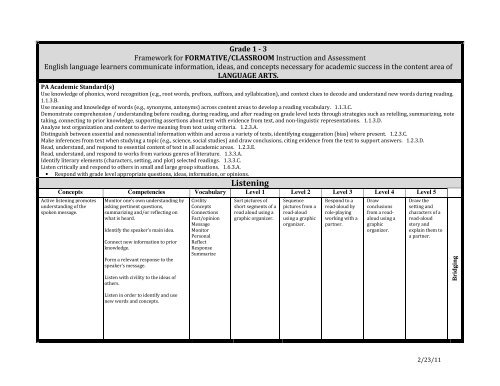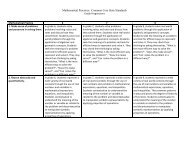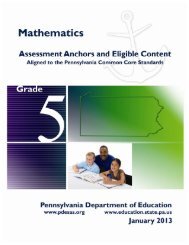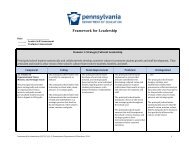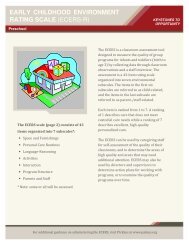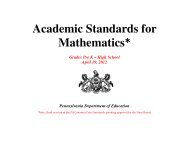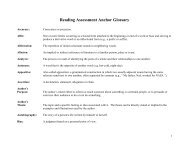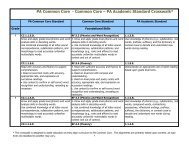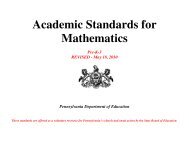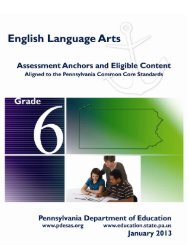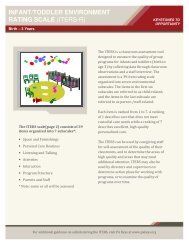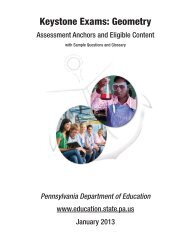Language Arts Overlay Gr 1-3 Listening and Reading - SAS
Language Arts Overlay Gr 1-3 Listening and Reading - SAS
Language Arts Overlay Gr 1-3 Listening and Reading - SAS
Create successful ePaper yourself
Turn your PDF publications into a flip-book with our unique Google optimized e-Paper software.
<strong>Gr</strong>ade 1 - 3<br />
Framework for FORMATIVE/CLASSROOM Instruction <strong>and</strong> Assessment<br />
English language learners communicate information, ideas, <strong>and</strong> concepts necessary for academic success in the content area of<br />
LANGUAGE ARTS.<br />
PA Academic St<strong>and</strong>ard(s)<br />
Use knowledge of phonics, word recognition (e.g., root words, prefixes, suffixes, <strong>and</strong> syllabication), <strong>and</strong> context clues to decode <strong>and</strong> underst<strong>and</strong> new words during reading.<br />
1.1.3.B.<br />
Use meaning <strong>and</strong> knowledge of words (e.g., synonyms, antonyms) across content areas to develop a reading vocabulary. 1.1.3.C.<br />
Demonstrate comprehension / underst<strong>and</strong>ing before reading, during reading, <strong>and</strong> after reading on grade level texts through strategies such as retelling, summarizing, note<br />
taking, connecting to prior knowledge, supporting assertions about text with evidence from text, <strong>and</strong> non-linguistic representations. 1.1.3.D.<br />
Analyze text organization <strong>and</strong> content to derive meaning from text using criteria. 1.2.3.A.<br />
Distinguish between essential <strong>and</strong> nonessential information within <strong>and</strong> across a variety of texts, identifying exaggeration (bias) where present. 1.2.3.C.<br />
Make inferences from text when studying a topic (e.g., science, social studies) <strong>and</strong> draw conclusions, citing evidence from the text to support answers. 1.2.3.D.<br />
Read, underst<strong>and</strong>, <strong>and</strong> respond to essential content of text in all academic areas. 1.2.3.E.<br />
Read, underst<strong>and</strong>, <strong>and</strong> respond to works from various genres of literature. 1.3.3.A.<br />
Identify literary elements (characters, setting, <strong>and</strong> plot) selected readings. 1.3.3.C.<br />
Listen critically <strong>and</strong> respond to others in small <strong>and</strong> large group situations. 1.6.3.A.<br />
• Respond with grade level appropriate questions, ideas, information, or opinions.<br />
<strong>Listening</strong><br />
Concepts Competencies Vocabulary Level 1 Level 2 Level 3 Level 4 Level 5<br />
Active listening promotes<br />
underst<strong>and</strong>ing of the<br />
spoken message.<br />
Monitor one’s own underst<strong>and</strong>ing by<br />
asking pertinent questions,<br />
summarizing <strong>and</strong>/or reflecting on<br />
what is heard.<br />
Identify the speaker’s main idea.<br />
Connect new information to prior<br />
knowledge.<br />
Form a relevant response to the<br />
speaker’s message.<br />
Listen with civility to the ideas of<br />
others.<br />
Listen in order to identify <strong>and</strong> use<br />
new words <strong>and</strong> concepts.<br />
Civility<br />
Concepts<br />
Connections<br />
Fact/opinion<br />
Message<br />
Monitor<br />
Personal<br />
Reflect<br />
Response<br />
Summarize<br />
Sort pictures of<br />
short segments of a<br />
read aloud using a<br />
graphic organizer.<br />
Sequence<br />
pictures from a<br />
read-aloud<br />
using a graphic<br />
organizer.<br />
Respond to a<br />
read-aloud by<br />
role-playing<br />
working with a<br />
partner.<br />
Draw<br />
conclusions<br />
from a readaloud<br />
using a<br />
graphic<br />
organizer.<br />
Draw the<br />
setting <strong>and</strong><br />
characters of a<br />
read-aloud<br />
story <strong>and</strong><br />
explain them to<br />
a partner.<br />
Bridging<br />
2/23/11
<strong>Reading</strong><br />
Concepts Competencies Vocabulary Level 1 Level 2 Level 3 Level 4 Level 5<br />
Essential content of text,<br />
including literary elements<br />
<strong>and</strong> literary devices,<br />
inform meaning of grade<br />
appropriate fiction <strong>and</strong><br />
literary nonfiction.<br />
Text features inform<br />
meaning of texts.<br />
Text features <strong>and</strong><br />
organization help inform<br />
author’s purpose.<br />
Acquire <strong>and</strong> apply a robust<br />
vocabulary to construct<br />
meaning.<br />
Summarize key information from text<br />
(e.g. major points, processes <strong>and</strong>/or<br />
events).<br />
Make predictions <strong>and</strong> draw<br />
inferences <strong>and</strong> conclusions based on<br />
text.<br />
Support assertions about text with<br />
evidence from text.<br />
Respond to text by questioning,<br />
reflecting on, <strong>and</strong> interpreting the<br />
essential content.<br />
Use text features to locate<br />
information, make predictions <strong>and</strong><br />
inferences draw conclusions, <strong>and</strong><br />
develop meaning.<br />
Identify the author’s purpose, citing<br />
examples from text.<br />
<strong>Gr</strong>oup concepts <strong>and</strong> ideas by common<br />
features <strong>and</strong> purpose.<br />
Caption<br />
Cause/effect<br />
Character<br />
Chart<br />
Compare /<br />
contrast<br />
Dialogue<br />
Essential<br />
information<br />
Event<br />
Fact<br />
Fiction<br />
Genre<br />
<strong>Gr</strong>aph<br />
Heading<br />
Illustrator<br />
Inference<br />
Main Idea<br />
Motives<br />
Narrator<br />
Non-fiction<br />
Opinion<br />
Plot<br />
Prediction<br />
Sequence<br />
Setting<br />
Sub-heading<br />
Summarize<br />
Table of contents<br />
Title<br />
Retell stories<br />
using a series of<br />
pictures.<br />
Comprehension<br />
Story retelling<br />
Amplify<br />
vocabulary<br />
Use cognates<br />
Pictures/<br />
illustrations<br />
Point to<br />
Sort<br />
Match<br />
Follow onestep<br />
directions<br />
Match sentence<br />
strips to<br />
illustrations in a<br />
story.<br />
Comprehension<br />
Order of events<br />
Amplify<br />
vocabulary<br />
Use cognates<br />
Follow twostep<br />
directions<br />
Select<br />
Sequence<br />
Sequence a<br />
series of<br />
illustrated<br />
sentence strips<br />
to tell a story.<br />
Content Stems<br />
Comprehension<br />
Order of events<br />
Identify phrases<br />
or sentences in<br />
a story that<br />
support the<br />
main idea<br />
working with a<br />
partner.<br />
Comprehension<br />
Main idea<br />
Supporting<br />
details<br />
Instructional Support<br />
Amplify<br />
vocabulary<br />
Use cognates<br />
<strong>Language</strong> Use<br />
Categorize<br />
Sequence<br />
Follow-multistep<br />
directions<br />
Locate, select,<br />
<strong>and</strong> order<br />
Amplify<br />
vocabulary<br />
Use cognates<br />
Compare <strong>and</strong><br />
contrast<br />
Identify<br />
cause/effect<br />
Participate in a<br />
reading/<br />
literature circle<br />
to draw<br />
conclusions<br />
about grade<br />
level text.<br />
Comprehension<br />
Draw<br />
conclusions<br />
Amplify<br />
vocabulary<br />
Use cognates<br />
Compare <strong>and</strong><br />
contrast<br />
Identify<br />
cause/effect<br />
Bridging<br />
2<br />
7/31/2009


